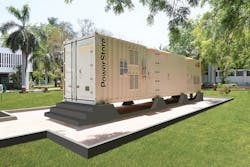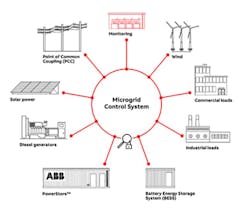Last year was a record-setting year for numbers and lengths of power outages. In California there were a great deal of wildfires and extreme weather conditions that increased fire dangers. As a result, there were record numbers of long duration public safety power shutoffs (PSPS), which were not well received by electricity consumers. Worldwide, extreme weather events caused a record number of storms, which were also responsible for many lengthy blackouts.
Several groups that track interruptions of electrical service noted that 2018 had been exceedingly bad and 2019 would probably surpass 2018. All the facts seem to say these extreme events are becoming the new norm and it would be best to be ready. So what can be done to keep the power flowing? That is a question that has opened a real can of worms for regulators, utilities, and even the customers.
In some areas, residential customers have been buying portable generators as fast as stores can unpack them, but they need a constant source of fuel. More appropriate is distributed energy resources (DER) technology. DER has gotten the attention of utilities charged with keeping the lights on, but there are regulatory and technical issues that need addressing. Who will pay for the equipment, how will it get into the rate base, will the DER system play nicely with the control and protection systems the utility has in place, and so on?
Solutions Increase
In 2018, Commonwealth Edison (ComEd) received approval from the Illinois Commerce Commission to develop the first utility microgrid cluster with the Bronzeville Community Microgrid (BCM), which is currently underway. ComEd said the BCM includes DER technology, such as battery energy storage systems, photovoltaic (PV) solar panels, and controllable generation. The Department of Energy has provided three grants for the project. The project incorporates the deployment of several innovative technologies needed for microgrids in urban areas including the development of a smart inverter that has grid-forming capabilities.
Commercial and industrial customers are showing a growing interest in DER technologies that quickly address correcting power outages when they happen. Microgrids powered by diesel generators, natural gas generators, fuel cells, flow batteries, etc. are at the top of the list, but it is solar that seems to be the technology of choice. After all, the sun provides the fuel and there are no moving parts.
Consumers gravitate toward simplicity and readily available technologies. PV panels are definitely simple and readily available. Also with dropping prices consumers have a wide range of PV systems available. Heck, go to any big box home improvement store on any weekend, and there are legions of PV salespeople stalking the aisles with products guaranteed to keep the lights on and cut electric bills.
These systems, however, are not microgrids because they are designed to shut down when they lose their connection with the grid. The important takeaway is these devices are being embraced by our customers, but they have to be modified to be a useful solution when the power isn’t available.
With all this talk about microgrids, what exactly is the device? IEEE (Institute of Electrical and Electronics Engineers) defines a microgrid as, "A group of interconnected loads and distributed energy resources within clearly defined electrical boundaries that acts as a single controllable entity with respect to the grid." Furthermore, IEEE goes on to say, "A microgrid can connect and disconnect from the grid to enable it to operate in both grid-connected or island mode."
Interestingly, there is a recent wrinkle in the microgrid offerings — the mobile microgrid. This device is a microgrid in every sense, but it’s portable. The concept of a transportable microgrid has been around for many years, but it is gaining attention because of all the energy focused on prolonged outages.
A Little History
Military deployments to remote parts of the world were one of the first applications for a portable power system, and self-contained microgrids made a lot of sense. A dependable power system was needed that could be packed in a shipping container and set up quickly. This arrangement became the basis for a transportable microgrid.
No matter the reasoning for developing a movable microgrid, it is being utilized in remote and densely populated areas alike, and the key element is modularity. Remember, utilities have taken advantage of mobile transformers, switchgear, substations, and many other portable devices for decades, and now suppliers are adding mobile microgrids to both sides of the meter.
In 2016, early news reports told of a collaboration between ABB, Laing O’Rourke and the Australian Renewable Energy Agency that resulted in one of the first portable hybrid microgrids. It was called SunSHIFT and was a hybrid system using PV and diesel generation with the ability of including future energy storage in the system. This first hybrid system included a 141 kilowatt peak (kWp) PV array and 1 megawatt (MW) of existing diesel generation located in a remote area of Queensland, Australia.
This early SunSHIFT system was reportedly placed in service within a week of leaving the factory and “six months later was packed up and relocated for use elsewhere.” The story went on to say the disassembly took about 170 hours of labor. Today’s SunSHIFT devices have matured and offer a wide range of features such as the recently announced OZ Minerals SunSHIFT hybrid system in Australia. It includes a 250 kW lithium-ion battery, 250 kW PV system and a 10 kW wind turbine integrated with a diesel power plant.
According to Maxine Ghavi, ABB’s head of the Grid Edge Solutions business, “For more than 30 years, ABB has been pioneering microgrid and battery energy storage systems. ABB’s Microgrid control and automation system was used in that first hybrid microgrid, and has continued to mature as a hybrid microgrid control system for today’s e-mesh portfolio. It can be applied to any type of multiple power generation sources used by a hybrid microgrid system. This automated controller (brain of the system) was designed to efficiently integrate multiple generation sources.”
Ghavi also said, “It has become the key element of today’s modular microgrid e-mesh PowerStore storage systems that not only provide continuous and resilient power for prolonged outages, but can also be used for peak shaving and load management.”
Another early system from about the same time frame came from GE. GE developed what it calls, “a microgrid in a box.” It is a hybrid microgrid utilizing PV and batteries and diesel, or natural gas genset with its Predix software. GE said it is a distributed power supply for weak grid areas, off grid applications, remote regions, or storm damaged locations. It has also been designed for easy scalability when more power is needed.
Recently, GE also has developed a vehicle-to-grid (V2G) DER system. GE’s V2G microgrid system uses electric vehicles (cars, buses, trucks, etc.) for the power source. They have the unique ability to drive the partially discharged vehicle to the closest energized part of the grid for recharging. This is ideal for prolonged outages in specific portions of the grid. See the November T&D World issue’s “Charging Ahead” segment for more details.
Modular Means Mobile
Go Electric, a subsidiary of Saft, supplies portable, modular, self-forming microgrids that can be deployed rapidly. The company has been providing modular microgrid systems for military and civilian use.
One notable project announced last year was a 400 kW microgrid for the Parker Ranch on the Big Island of Hawaii. Go Electric reported that the ranch requires pumping stations to provide water for its cattle, and power outages over the years have been a large problem for the supplying adequate water to the cattle. The microgrid includes a 225 kW PV array, 250 kW of energy storage and diesel backup.
Schneider Electric’s Villaya Emergency is an easy to transport containerized modular PV microgrid. It is designed to be a plug-and-play microgrid with easy install, usually in less than 30 minutes after arrival at its final destination. The microgrid is powered by PV panels, has battery storage, inverters, and remote monitoring capabilities. Schneider Electric describes the mobile system as being modular with kits rated from 7 kWp to 65 kWp (24 to 240 modules).
Just having solar panels doesn’t provide electricity during an outage. They need to able to disconnect from the grid with storage, and that is where Tesla Solar has been turning heads. Tesla Solar provides rooftop PV, the electronics, and their Powerwall energy storage system. These modular systems don’t come cheap, but after the 2019 power outages in California and the 2019 hurricane season consumers are considering the investment.
Mobile microgrid technology is available, and it is rapidly deployable, but the technology needs regulatory support on the local, state, and federal levels. If we can overcome the obstacles, the power system stakeholders and customers can benefit from a resilient and dependable grid. It is an interesting time for everyone involved with the power delivery system.
About the Author
Gene Wolf
Technical Editor
Gene Wolf has been designing and building substations and other high technology facilities for over 32 years. He received his BSEE from Wichita State University. He received his MSEE from New Mexico State University. He is a registered professional engineer in the states of California and New Mexico. He started his career as a substation engineer for Kansas Gas and Electric, retired as the Principal Engineer of Stations for Public Service Company of New Mexico recently, and founded Lone Wolf Engineering, LLC an engineering consulting company.
Gene is widely recognized as a technical leader in the electric power industry. Gene is a fellow of the IEEE. He is the former Chairman of the IEEE PES T&D Committee. He has held the position of the Chairman of the HVDC & FACTS Subcommittee and membership in many T&D working groups. Gene is also active in renewable energy. He sponsored the formation of the “Integration of Renewable Energy into the Transmission & Distribution Grids” subcommittee and the “Intelligent Grid Transmission and Distribution” subcommittee within the Transmission and Distribution committee.

